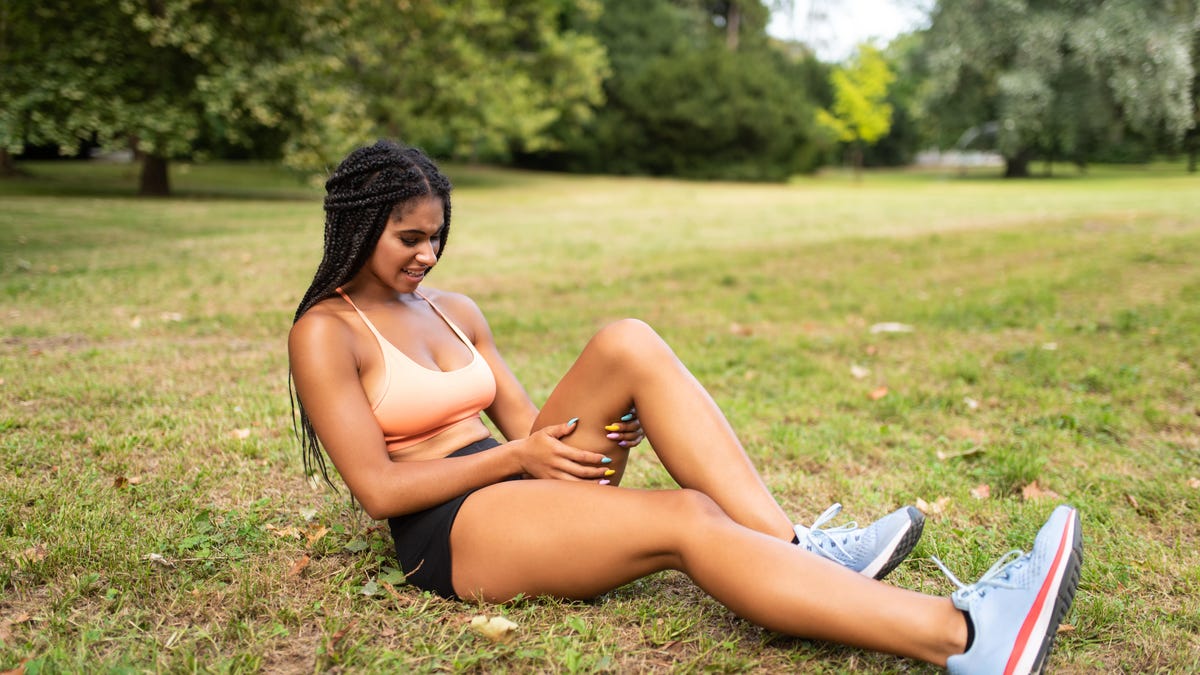3 Easy Ways to Prevent Chafing This Summer
Stay chafe-free and dry even in the sweatiest weather.

Summertime brings longer days, heat waves, humidity, sweat and you guessed it — chafing. If you've ever fallen victim to chafing, then you know how uncomfortable and painful it can be. Chafing can occur on almost any part of your body, but it's most likely to happen on your thighs, underarms, breasts or nipples and groin area, according to Healthline. This happens due to friction and constant rubbing between skin-on-skin or skin-on-clothing, which causes irritation and can even lead to a rash or blistered skin. Throw in sweat and heat and it's a recipe for a guaranteed chafing disaster. Hence why during the summer you may chafe more, especially if you're more active.
Luckily, there are some ways you can keep chafing at bay. Some of these include wearing specific types of fabric, as well as keeping the area treated. Read on to learn how to keep your body chafe-free this summer with the help of experts.
Choose your clothing fabrics wisely
When wearing clothes in the summer, try to avoid cotton on those muggy days. Cotton holds onto moisture and if you're sweating, it doesn't dry fast enough, which increases your chances of chafing and developing a painful skin irritation. Dr. Todd Minars, a dermatologist and assistant clinical professor of dermatology at the University of Miami School of Medicine, suggests opting for synthetic fabrics instead. Another recommended option is wearing loose-fitting clothing made of chiffon, silk, bamboo or hemp fabric varieties.
"Instead of wearing your old cotton shirt for a run, try one of the many 'athletic' or 'technical' fabrics offered today because they have sweat-wicking properties," Minars says. This type of fabric allows for more cooling airflow, minimizing friction. Likewise, he advises wearing synthetic fabrics such as nylon for your undergarments. He recommends the Soffe Ranger Panty, which is a favorite among the US military and athletes since it is made up of a lightweight nylon and keeps you dry and chafe-free.
According to Von Collins, cycling writer, coach and the founder of Complete Tri, if you're a runner or cyclist, you have to be even more mindful of what you're wearing. "It is really important to have high-quality running or bike shorts because low-quality or older shorts often have seams that begin to fray and that's enough to cause chafing over the course of a long run or ride," Collins says. He also says that runners should use shorts that cover their inner thighs. "Shorts that are too short or too baggy may allow the skin on the inner thigh to rub, especially for people with more muscular legs."
Keep the area lubricated
It might sound unappealing to keep the areas that are prone to chafing lubricated, but this tip works. When I was training for my first full marathon, it was during the dog days of summer. I can still remember the stinging on my underarms and thighs upon hopping in the shower after a long run. I never made that mistake again; I was saved by Body Glide, a balm specifically designed to prevent chafing. As a cheaper alternative, I also used Vaseline.
Minars says, "Another option besides clothing is applying a type of chamois cream, which is a viscous cream that helps reduce or possibly eliminate friction between skin and clothing." He suggests also looking for anti-chafe salves that are commonly found in triathlon and hiking retailers or retailer websites. Some alternatives you can find at your local drug are moisturizers such as Aquaphor, petroleum jelly, Cerave and Cetaphil. However, if you do end up having a chafing episode, Collins swears by a popular diaper rash ointment. "The secret weapon is to use Desitin at night and it works wonders."
Use a protective layer
In some cases you may be more prone to chafing in certain areas no matter what you do, so it helps to set up a physical protective barrier, beyond just a balm or moisturizer. "If you tend to chafe in the nipple area, I'd suggest using Band-Aids, pasties or specialty products made for athletes," says Minars.
For women, wearing shapewear under your dresses or skirts -- such as Thigh Society or Undersummers shorts -- can be helpful for preventing thigh chafing. Most of these are intended to safeguard against chafing and don't roll up, and they're breathable, stretchy and light.
Long story short
Chafing can happen to anyone, but there are simple solutions to deal with the discomfort. Sometimes it takes you by surprise and you can self-treat at home, but if you can prevent it before it happens, all the better to save you the trouble.
The good thing is these solutions are attainable and vary in price, so you can decide on what fits your budget best. Try these methods and see what works best for you.

